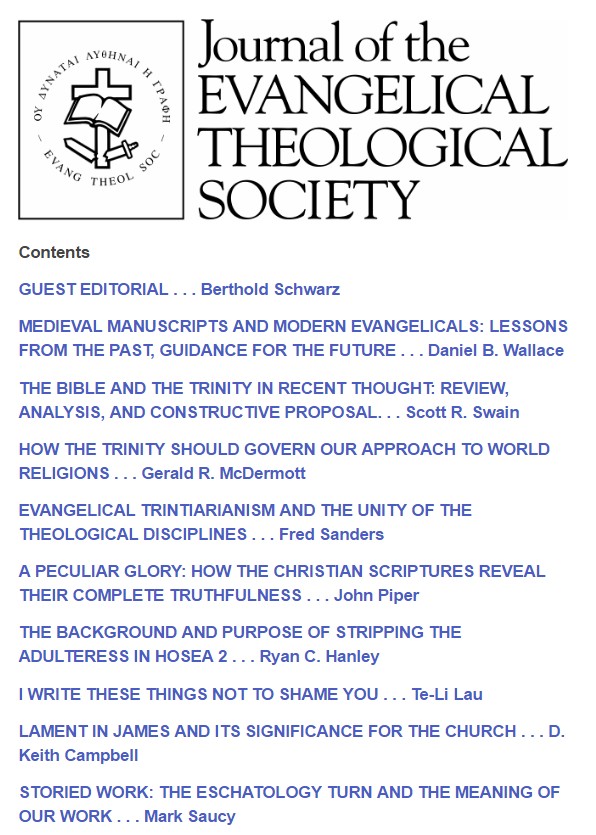 The new issue of the Journal of the Evangelical Theological Society is out, and it’s got plenty of Trinitarian theology in it. Don’t miss Scott Swain’s article on the Bible and the Trinity, and Gerald McDermott’s piece on the Trinity and world religions.
The new issue of the Journal of the Evangelical Theological Society is out, and it’s got plenty of Trinitarian theology in it. Don’t miss Scott Swain’s article on the Bible and the Trinity, and Gerald McDermott’s piece on the Trinity and world religions.
It’s also got my article “Evangelical Trinitarianism and the Unity of the Theological Disciplines,” in which I explain the vocation of the Trinity salesman, and make controversial claims such as “the Trinity is big.”
But probably I should refer to this article by the title, “Evangelical Trintiarianism,” because that typographical blunder is what I actually wrote and turned in for publication.
Trin-Ti-Arianism, whatever that is. I checked the manuscript, and the error is my own; the JETS copy editors didn’t save me from myself, alas! For a while, I considered putting a brave face on and pretending I spelled it that way on purpose. In the age of search engines, I could really dominate the online discourse regarding a word with a unique spelling. But it turns out I’m not the only one ever to have published the word ‘trintiarianism.’
Well, the article will make its way to subscribers in due course, and will be available online at some point. Here is one of my favorite sections, on the Trinitarian (note kerrekt spelling) nature of Christian ministry. This is what I mean when I talk about something called “evangelical Trinitarianism:”
Authentic gospel ministry is never without the Trinity; it is always within the Trinity.
Every element of gospel ministry can be fruitfully analyzed to show its Trinitarian depth. The crucial analytical question to ask is never simply, “Where can I find the number three in this?” The crucial analytical question is always, “What are the Son and the Holy Spirit doing in this ministry?”
Trinitarian analysis of gospel ministry is more a matter of counting to two than to three. Because the Son and the Spirit are the sent persons, whose sending constitutes the economy of salvation and revelation, they are the persons to watch. The sending Father is available to us, active toward us, and engaged with us, in the twofold mission of the Son and Spirit. We do not look to the sky to wait for the coming of the Father; he always sends and is never sent.
Irenaeus of Lyons used a homey illustration of this twofold sending:
He talked about the Father’s two hands. When Gnostics said God was too high to touch the world, delegating it rather to angelic intermediaries, Irenaeus replied, “God the Father is never without his two hands, the Son and the Spirit.” By calling the Son and Holy Spirit the Father’s two hands, Irenaeus draws our attention to the differentiated unity of God’s work. In doctrinal terms, this Irenaean two-handedness can be described as the constant correlation to Christology and pneumatology.It is remarkable how much the NT vision of ministry opens up to our understanding when we direct careful attention to the distinguishable and coordinated work of the Son and the Holy Spirit. And it is equally remarkable how much the Father’s presence and power are discernible in the work of his two emissaries, because to be in the grip of Christ and the Spirit is to belong to God the Father.